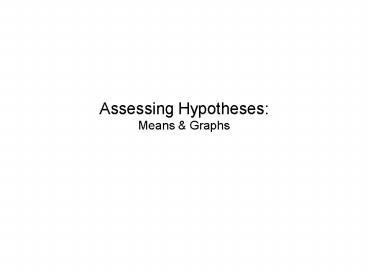Assessing Hypotheses: Means - PowerPoint PPT Presentation
Title:
Assessing Hypotheses: Means
Description:
Assessing Hypotheses: Means & Graphs – PowerPoint PPT presentation
Number of Views:60
Avg rating:3.0/5.0
Title: Assessing Hypotheses: Means
1
Assessing HypothesesMeans Graphs
2
Lecture plan
- Hypotheses
- Cross-tabs, means, or graphs?
- Comparing means
- Creating and interpreting graphs
3
Hypotheses
- What are hypotheses?
- Testable statements about empirical relationships
- Derived from theory.
- Examples
- The more religious are more Republican.
- Democratic states do not go to war with one
another. - Droughts depress the vote of the Democratic
party. - How do we test hypotheses?
- It depends on the data.
4
Continuous DV
- Crosstabs works for nominal and ordinal dependent
and independent variables - But what do we do when the dependent variable is
interval and the independent variable is nominal? - Compare means Bar chart (more on this later).
- What do you do when the dv is interval and the iv
is ordinal? - Line graph (more on this later).
- When both are interval?
5
Continuous v. Nominal
- Lets start with a question that has puzzled
social scientists for centuries - Do Canadians have more fun than Brits and
Americans? - So we hypothesize Canadians will report higher
levels of fun than Brits and Americans. - Validity problems?
6
Do Canadians Have More Fun?
- Fortunately, you have a thermometer measuring
the self-reported fun experienced by Canadians,
Brits, and Americans (technically called the
Fun-O-Meter). - What is your (continuous) DV?
- What is your (nominal) IV?
- How would you test the hypothesis that Canadians
have more fun than Brits or Americans?
7
Comparing Means
- Right-O!
- Compare the mean of the dependent variable across
values of the independent variable. - This is how you do it
8
Comparing Means
- Who has more fun?
Nationality Mean N Std. Deviation
Canadians 98.50 3 4.163
British 75.750 4 13.744
Americans 91.667 2 .70711
Total 86.111 9 13.37
9
Graphical Comp of Means Bar Chart
TV hours per week
- Continuous v. categorical (nom, ord)
- This is not a frequency bar chart!
10
Howd that happen?
- Graphs ? Bar
- Simple
- Summaries
- Define
11
Bye Bye Nominal Hello Line Graphs
- Works for all levels of measurement except
nominal data - Continuous v. nominal (ordinal) Complements
means comparison. - Ordinal v. Ordinal (numerically coded)
- Continuous v. Continuous
- Lets look at ourselves again
- Two ordinal variables
- 7-category Dem Party L-R Placement Variable
- 5-category Religious Attendance Variable
- Do more religiously observant students view the
Dem Party differently than less observant
students?
12
Line Graph Dem L-R v. Religious
- Negative Relationship
13
Line Graph Rep L-R v. Religious
- positive
- or
- curvilinear
14
Howd that happen?
- Graphs ? lines
- Simple
- Summaries for groups of cases
- Define
- Next
- Other summary function
- Enter variables
- OK
15
Continuous v. Continuous?
- Hmm what if BOTH the dependent and independent
variables are continuous? - DV Hours spent exercising and playing sports.
- IV Hours spent watching TV.
- What would happen if we just line graphed TV
against exercise???
16
Hmm
17
- This rolling average takes the mean of the
original observation and those two hours before
and after.
18
- Or, we can categorize one of the variables.

